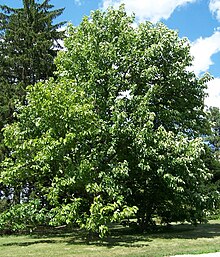| Cucumber tree | |
|---|---|

| |
| Magnolia acuminata, Morton Arboretum acc. 1046-3*1 | |
| Scientific classification | |
| Kingdom: | Plantae |
| Clade: | Tracheophytes |
| Clade: | Angiosperms |
| Clade: | Magnoliids |
| Order: | Magnoliales |
| Family: | Magnoliaceae |
| Genus: | Magnolia |
| Subgenus: | Magnolia subg. Yulania |
| Section: | Magnolia sect. Yulania |
| Subsection: | Magnolia subsect. Tulipastrum (Spach) Figlar & Noot |
| Species: | M. acuminata
|
| Binomial name | |
| Magnolia acuminata (Linnaeus)
| |

| |
Magnolia acuminata, commonly called the cucumber tree (often spelled as a single word "cucumbertree"), cucumber magnolia or blue magnolia, is one of the largest magnolias, and one of the cold-hardiest. It is a large forest tree of the Eastern United States and Southern Ontario in Canada. It is a tree that tends to occur singly as scattered specimens, rather than in groves.[2]
The cucumber tree is native primarily within the Appalachian belt, including the Allegheny Plateau and Cumberland Plateau, up to western Pennsylvania and New York. There are also numerous disconnected outlying populations through much of the southeastern U.S., and a few small populations in Southern Ontario. In Canada, the cucumber tree is listed as an endangered species and is protected under the Canadian Species at Risk Act.[3] In 1993 The North American Native Plant Society purchased Shining Tree Woods to preserve a stand of Magnolia acuminata, which is also known as "The Shining Tree".
The leaves are deciduous, simple and alternate, oval to oblong, 12–25 centimetres (4.7–9.8 in) long and 6–12 centimetres (2.4–4.7 in) wide, with smooth margins and downy on the underside. They come in two forms, acuminate at both ends, or moderately cordate at the base (these are usually only formed high in the tree).
Unlike most magnolias, the flowers are not showy. They are typically small, yellow-green, and borne high in the tree in April through June. The leaves of Magnolia acuminata are pointed at the tip and provide it with its name - 'acuminate' means tapering to a fine point. The name "cucumber tree" refers to the unripe fruit, which is green and often shaped like a small cucumber; the fruit matures to a dark red color and is 6–8 centimetres (2.4–3.1 in) long and 4 centimetres (1.6 in) broad, with the individual carpels splitting open to release the bright red seeds, 10–60 per fruit. The ripe fruit is a striking reddish orange color.
- ^ Khela, S. (2014). "Magnolia acuminata". IUCN Red List of Threatened Species. 2014: e.T193896A2289975. doi:10.2305/IUCN.UK.2014-1.RLTS.T193896A2289975.en. Retrieved 19 November 2021.
- ^ Sternberg, G., & Wilson, J. (2004). Native Trees for North American Landscapes. Portland, Oregon:Timber Press
- ^ White, D.J. (2000). Update COSEWIC Status Report on the Cucumber Tree Magnolia acuminata in Canada. Committee on the Status of Endangered Wildlife in Canada. Ottawa, Ontario
